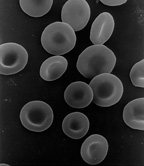Iron deficiency anemia facts for kids
Quick facts for kids Iron-deficiency anemia |
|
|---|---|
| Synonyms | Iron-deficiency anaemia |
 |
|
| Red blood cells | |
| Symptoms | Feeling tired, weakness, shortness of breath, confusion, pallor |
| Complications | Heart failure, arrhythmias, frequent infections |
| Causes | Iron deficiency |
| Diagnostic method | Blood tests |
| Treatment | Dietary changes, medications, surgery |
| Medication | Iron supplements, vitamin C, blood transfusions |
| Frequency | 1.48 billion (2015) |
| Deaths | 54,200 (2015) |
Iron-deficiency anemia happens when your body doesn't have enough iron. Iron is super important because it helps your blood make hemoglobin. Hemoglobin is a special protein in your red blood cells. It carries oxygen from your lungs to all parts of your body.
When you don't have enough iron, your body can't make enough healthy red blood cells. This means your body doesn't get enough oxygen. That's what we call anemia.
Contents
What Are the Signs of Iron-Deficiency Anemia?
Sometimes, if anemia starts slowly, you might not notice it much at first. But over time, you might feel:
- Very tired or weak
- Short of breath
- Like you can't exercise well
If anemia comes on quickly, the signs can be stronger. You might feel:
- Confused
- Like you're going to faint
- Very thirsty
One common sign is looking pale. This happens because your blood doesn't have enough red, oxygen-rich cells. For kids, not having enough iron can also affect their growth and how they learn.
What Causes Iron-Deficiency Anemia?
Iron-deficiency anemia usually happens for a few main reasons:
- Blood Loss: Losing blood, even a little bit over time, can cause this. For example, if someone has a cut that bleeds a lot or if girls have heavy periods.
- Not Enough Iron in Food: If you don't eat enough foods that have iron, your body won't get what it needs.
- Poor Iron Absorption: Sometimes, your body might not be able to soak up the iron from the food you eat very well.
How Can We Prevent and Treat It?
The good news is that iron-deficiency anemia can often be prevented and treated.
Preventing Iron Deficiency
You can help prevent it by eating foods rich in iron. Some great iron-rich foods include:
- Red meat
- Beans and lentils
- Spinach and other dark leafy greens
- Fortified cereals (cereals with added iron)
Sometimes, doctors might suggest taking iron supplements if you're at risk.
Treating Iron Deficiency Anemia
Treatment depends on what's causing the anemia. It might involve:
- Changing Your Diet: Eating more iron-rich foods.
- Medications: Doctors often prescribe Iron supplements. They might also suggest taking vitamin C. Vitamin C helps your body absorb iron better.
- Blood Transfusions: In very serious cases, a doctor might give a blood transfusion. This means getting healthy blood from another person.
- Surgery: If the anemia is caused by ongoing blood loss from a specific problem, surgery might be needed to fix it.
How Common Is It?
Iron-deficiency anemia is quite common around the world. In 2015, about 1.48 billion people were affected by it. Not getting enough iron from food causes about half of all anemia cases globally. Young children and women are most often affected.
How Is It Diagnosed?
Doctors can find out if you have iron-deficiency anemia with a simple blood test. This test checks how much hemoglobin is in your blood. If the levels are too low, it's a sign of anemia.
Images for kids
See also
 In Spanish: Anemia ferropénica para niños
In Spanish: Anemia ferropénica para niños




